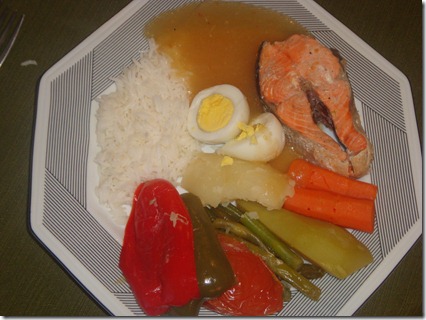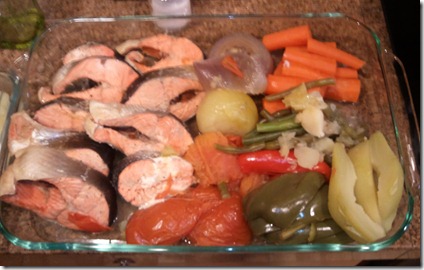Source: Modified from the series “Cozinha Regional Brasileira” (Brazilian Regional Cuisine, http://www.cozinharegional.com.br), book 6 (Pernambuco)
History: “Peixada” is a very common dish in the state of Pernambuco, and growing up there I had it a lot. Usually made in large quantities for a big family reunion, it consists basically in a large fish stew with lots, lots of vegetables, and a hard-boiled egg. It’s always served with white rice and “pirão”, a creamy side dish made with the liquid from the stew and yucca flour (another typical ingredient in Brazilian cooking). The fish mostly used is called “cavala” (similar to Spanish mackerel), cut in steaks with the bone in.
Variation from the original: I couldn’t find the mackerel, and the only fish in steaks with bone I could find was salmon (I had to buy a whole one and ask for the person in the counter to chop it for me), so salmon it was (with the added advantage that salmon is one of the cheapest fishes around here). It tasted really good, and the only problem was that the fish bones didn’t come out quite easily, so we had more work than usual to eat it. Other things were that I didn’t find fish heads to make the stock (I only went to one supermarket, and they didn’t have any kind of fish heads), so I used a few pieces from the tail. I also couldn’t find all the vegetables listed in the recipe (okra and “maxixe”, which I don’t know the translation to English). I also changed some of the amounts of the ingredients to match what I had at home.
Ingredients from specialty stores: I got the “farinha” (toasted ground yucca root) from a Brazilian store. Everything else was found in my local Fred Meyer.
Ingredients:
- For the fish stock:
- 1/2 lb fish tail / meat (as I mentioned, fish heads would be better, and in larger amount – the recipe asked for 1Kg, ~2lb)
- 1 onion, chopped in large chunks
- 2 tomatoes, chopped
- 1 green bell pepper, chopped in large chunks
- 1 cup of chopped cilantro
- 1 cup of chopped green onions
- 6 minced garlic cloves
- 4 bay leaves
- 3 quarts of water
- salt & pepper
- For the fish:
- 1 medium salmon (about 3lb), chopped in 1”-thick steaks
- 6 garlic cloves
- juice of 1 lime
- salt & pepper
- 2 tomatoes, cut in half
- 1 red bell pepper, cut in 4 quarters
- 1 green bell pepper, cut in 4 quarters
- 1 red onion
- 1 yellow onion
- 4 medium potatoes
- 4 carrots, chopped in 2-3” pieces
- 1 chayote squash, cut in 4 quarters (seed removed)
- 1 head of cabbage, cut in 4 quarters
- 1/2 lb. of green beans, ends trimmed
- 4 hard-boiled eggs
- For the “pirão”:
- 5 cups of the liquid from the stew
- 1/2 to 1 cup of “farinha”
Prepare the stock: put all ingredients in a large pot and start cooking; when it starts boiling, cook for another 30 minutes, then reserve.
Season the fish with the lime juice, salt and pepper, then reserve. Strain the stock, removing all the vegetables and the fish, and return it to the (large) pot in the stove. When it starts boiling again, start adding the vegetables, in reverse order of their time to cook: first carrots, chayote and cabbage, then potatoes, onions and green beans, then bell peppers. The last thing to go to the pan is the fish, since it cooks quite fast (it took about 10 minutes for the salmon), being careful not to overcook.
When the fish is done, remove 4-5 cups of the liquid to another pan to prepare the “pirão”: with the stove at medium heat, stirring constantly, slowly add the “farinha” until it starts to thicken (careful not to add too much of it, since after you take it out of the stove it will thicken a little more) – for me it’s usually after a little more of 1/2 cup of “farinha”.
Arrange the vegetables in a serving dish with the steaks, some of the stock and the eggs cut in half. Serve with the “pirão” and white rice.
Enjoy!


Pingback: Cozido (Stew) | Food & Tech